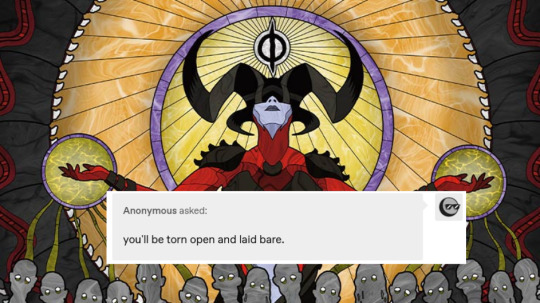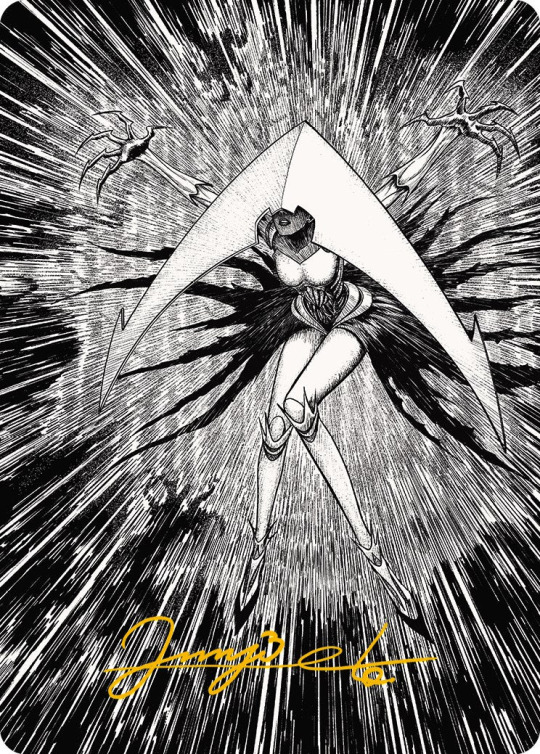#phyrexia
Text
TUMBLR POST EDITOR WON'T LET ME TITLE THIS POST ANYMORE SO I GUESS THIS IS THE TITLE NOW. WEBBED SITE INNIT
So let's say you grew up in the nineties and that The Lion King was an important movie to you. Let's say that the character of Scar - snarling, ambitious, condescending, effeminate Scar - stirred feelings in you which you had no words for as a child. And then let's say, many years later, you're talking about it with a college friend, and you say something like, "oh man, I think Scar was some sort of gay awakening for me," and she fixes you with this level stare and says, "Scar was a fascist. What's the matter with you?"

The immediate feeling is not unlike missing a step: hang on, what's happening, what did I miss? You knew there were goose-stepping hyenas in "Be Prepared," but you didn't think it mattered that much. He's the bad guy, after all, and the movie's just pointing it out. Your friend says it's more than that: the visuals of the song are directly referencing the Nuremberg rallies. They're practically an homage to Riefenstahl. This was your sexual awakening? Is this why you're so into peaked caps and leather, then? Subliminal nazi kink, perhaps?
And then one of your other friends cuts in. "Hold up," he says, "let's think about what Scar actually did in the movie. He organized a group of racialized outcasts and led them against a predatory monarchy. Why are you so keen to defend their hereditary rule? Scar's the good guy here." The conversation immediately descends into a verbal slap fight about who the real bad guy is, whether Scar's regime was actually responsible for the ecological devastation of the Pride Lands, whether the hyenas actually count as "racialized" because James Earl Jones voiced Mufasa after all. Your Catholic friend starts saying some strange and frankly concerning shit about Natural Law. Someone brings The Lion King 2 into it. You leave the conversation feeling a little bit lost and a little bit anxious. What were we even talking about?
INTRODUCING: THE DITCH
There is a way of reading texts which I'm afraid is pervasive, which has as its most classical expression the smug obsession with trivia and minutiae you find in a certain vein of comic book fan. "Who was the first Green Lantern? What was his weakness? Do you even know the Green Lantern Oath?" It eschews the subjective in favor of definitively knowable fact. You can't argue with this guy that, say, Alan Scott shouldn't really count as the first Green Lantern because his whole deal is so radically different from the Hal Jordan/John Stewart/Guy Gardner Corps-era Lanterns, because this guy will simply say "but he's called Green Lantern. Says so right on the cover. Checkmate." This approach to reading a text is fundamentally 1) emotionally detached (there's a reason the joke goes, oh you like X band? name three of their songs - and not, which of their songs means the most to you? which of them came into your life at exactly the right moment to tell you exactly what you needed to hear just then?) and 2) defensive. It's a stance that is designed not to lose arguments. It says so right on the cover. Checkmate.
And then you get the guys who are like "well obviously Bruce Wayne could do far more as a billionaire to solve societal problems by using his tremendous wealth to address systemic issues instead of dressing up as a bat and punching mental patients in the head," and these guys have half a point but they're basically in the same ditch butting heads with the "well, actually" guys, and can we not simply extricate ourselves from the ditch entirely?
So, okay, let's return to our initial example. Scar is portrayed using Nazi iconography - the goose-stepping, the monumentality, the Nuremberg Lichtdom. He is also flamboyant and effete. He unifies and leads a group of downtrodden exiles to overthrow an absolute monarch. He's also a self-serving despot on whose rule Heaven Itself turns its back. You can't reconcile these things from within the ditch - or if you can, the attempt is likely to be ad-hoc supposition and duct tape.
Instead, let's ask ourselves what perspective The Lion King is coming from. What does it say is true about the world? What are its precepts, its axioms?
There is a natural hierarchical order to the world. This is just and righteous and the way of things, and attempts to overthrow this order will be punished severely by the world itself.
Fascism is what happens when evil men attempt to usurp this natural order with the aid of a group or groups of people who refuse to accept their place in the order.
There exists an alternative to defending and adhering to one's place in the natural order - it consists only of selfish spineless apathy.
Manliness is an essential quality of a just ruler. Unmanliness renders a person unfit for rule, and often resentful and dangerous as well.
And isn't that interesting, laid out like that? It renders the entire argument about the movie irrelevant (except for whatever your Catholic friend was on about, since his understanding of the world seems to line up with the above precepts weirdly well.) It's meaningless to argue about whether Scar was a secret hero or a fascist, when the movie doesn't understand fascism and has a damn-near alien view of what good and evil are.
There's always gonna be someone who, having read this far, wants to reply, "so, what? The Lion King is a bad movie and the people who made it were homophobes and also American monarchists, somehow? And anyone who likes it is also some sort of gay-bashing crypto-authoritarian?" To which I have to reply, man, c'mon, get out of the ditch. You're no good to anyone in there. Take my hand. I'm going to pull on three. One... two...
SO PHYREXIA [PAUSE FOR APPLAUSE, GROANS]
We're talking about everyone's favorite ichor-drooling surgery monsters again because there was a bit in my ~*~seminal~*~ essay Transformation, Horror, Eros, Phyrexia which seemed to give a number of readers quite a bit of trouble: namely, the idea that while Phyrexia is textually fascist, their aesthetic is incompatible with real-world fascism, and further, that this aesthetic incompatibility in some way outweighs the ways in which they act like a fascist nation in terms of how we think of them. I'll take responsibility here: I don't think that point is at all clear or well-argued in that essay. What I was trying to articulate was that the text of Magic: the Gathering very much wants Phyrexia to be supremely evil and dangerous fascists, because that makes for effective antagonists, but in the process of constructing that, it's accidentally encoded a whole bunch of fascinating presuppositions that end up working at cross-purposes with its apparent aim. That's... not that much clearer, is it? Hmm. Why don't I just show you what I mean?
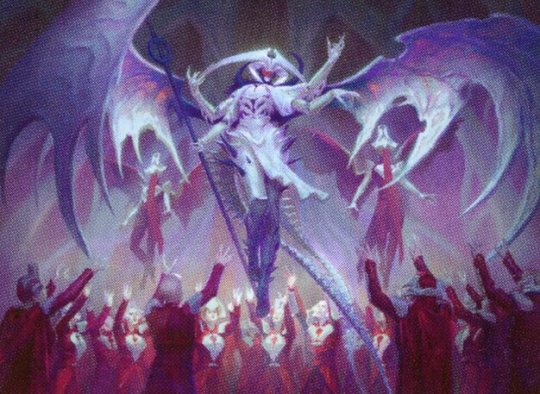
Atraxa, Grand Unifier (art by Marta Nael)
In "Beneath Eyes Unblinking," one of the March of the Machine stories by K. Arsenault Rivera, there's a fascinating and I think revealing passage in which Atraxa (big-deal Phyrexianized angel and Elesh Norn's lieutenant) has a run-in with an art museum in New Capenna. The first thing I want to talk about is that, in this passage, Atraxa has no understanding of the concept of "beauty". A great deal of space in such a rushed storyline is devoted to her trying to puzzle out what beauty means and interrogating the minds of her recently-compleated Capennan aesthetes to try and understand it. In the end, she is unable to conceive of beauty except as "wrongness," as anathema.
So my first question is, why doesn't Atraxa have any idea of beauty? This is nonsense, right? We could point to a previous story, "A Garden of Flesh," by Lora Gray, in which Elesh Norn explicitly thinks in terms of beauty, but that's a little bit ditchbound, isn't it? The better argument is to simply look at Phyrexian bodies, at the Phyrexian landscape, all of which looks the way it does on purpose, all of which has been shaped in accordance with the very real aesthetic preferences of Phyrexians. How you could look at the Fair Basilica and not understand that Phyrexians most definitely have an idea of beauty, even if you personally disagree with it, is baffling. This is a lot like the canonical assertion that Phyrexians lack souls, which is both contradicted elsewhere in canon and essentially meaningless, given Magic's unwillingness or inability to articulate what a soul is in its setting, and as with this, it seems the goal is simply to dehumanize Phyrexians, to render them alien, even at the cost of incoherence or internal contradiction.
Atraxa's progress through the museum is fascinating. It evokes the 1937 Nazi exhibit on "degenerate art" in Munich, but not at all cleanly. The first exhibit, which is of representational art, she angrily destroys for being too individualistic (a point of dissonance with the European fascist movements of the 20th century, which formed in direct antagonism to communism.) The second exhibit, filled with abstract paintings and sculptures, she destroys even more angrily for having no conceivable use (this is much more in line with the Nazi idea of "degenerate art", so well done there.) The third exhibit is filled with war trophies and reconstructions from a failed Phyrexian invasion of Capenna many years prior, which she is angriest of all with (and fair enough, I suppose.) But then, after she's done completely trashing the place, she spots a number of angel statues on the cathedral across the plaza, and she goes apeshit. In a fugue of white-hot rage, she pulverizes the angel heads, and here is where I have to ask my second question:
Why angels? If you are trying to invoke fascist attitudes toward art, big statues of angels are precisely the wrong thing for your fascist analogues to hate. Fascists love monumental, heroic representations of superhuman perfection. It's practically their whole aesthetic deal. I understand that we're foreshadowing the imminent defeat of Phyrexia at the hands of legions of angels and a multiversal proliferation of angel juice, but that just leads to the exact same question: why angels? To the best of my knowledge, the Phyrexian weakness to New Capennan angel juice is something invented for this storyline. They have, after all, been happily compleating angels since 1997. We could talk about the in-universe justification for why Halo specifically is so potent, but I don't remember what that justification is, and also don't care. Let's not jump back in the ditch, please. The point is, someone decided that this time, Phyrexia would be defeated by an angelic host, and what does that mean? What is the text trying to say? What are its precepts and axioms?
Let me ask you a question: how many physically disabled angels are there in Magic: the Gathering? How about transsexual angels? How many angels are there, on all of the cards that have ever been printed for Magic: the Gathering, that are even just a bit ugly? Do you get it yet? Or do you need me to spell it out for you?
SPELLING IT OUT FOR YOU
There is a kind of body which is bad. It is bad because it has been significantly altered from its natural state, and it is bad because it is repellent to our aesthetic sensibilities.
The bad kind of body is contagious. It spreads through contact. Sometimes people we love are infected, and then they become the bad kind of body too.
There is a kind of body which is good. It is good because it is pleasing to our aesthetic sensibilities, and it is good because it is unaltered from its (super)natural state.
A happy ending is when all the good bodies destroy or drive into hiding all of the bad bodies. A happy ending is when the bad bodies of the people we love are forcibly returned to being the good kind of body.
Do you get it now?
ENDNOTES
It's worth noting that the ditch is very similar to the white American Evangelical hermeneutics of "the Bible says it. I believe it. That settles it," the defensive chapter-and-verse-or-it-didn't-happen approach to reading a text, what Fred Clark of slacktivist calls "concordance-ism". I don't think that's accidental. We stand underneath centuries of people reading the Bible very poorly - how could that not affect how we read things today? We are participants in history whether we like it or not.
I sincerely hope I haven't come across as condescending in this essay. Close reading is legitimately difficult! They teach college courses on this stuff! And while it is frustrating to have my close readings interrogated by people who... aren't doing that, like. I do get it. I find myself back in the ditch all the time. This stuff is hard. It is also, sorry, crucial if you intend to say something about a text that's worth saying.
I also hope I've communicated clearly here. Magic story is sufficiently incoherent that trying to develop a thesis about it often feels like trying to nail jello to the wall. If anyone has questions, please ask them! And thank you for reading. Next time, we'll probably do the new Eldraine set.
#phyrexia#not defining the ditch except by implication#thanks to all the very smart vorthoi on the flavor text discord server for helping me work through my thoughts on fascism and phyrexia#this is technically the march of the machine review also#or as much of one as i care to do
5K notes
·
View notes
Text

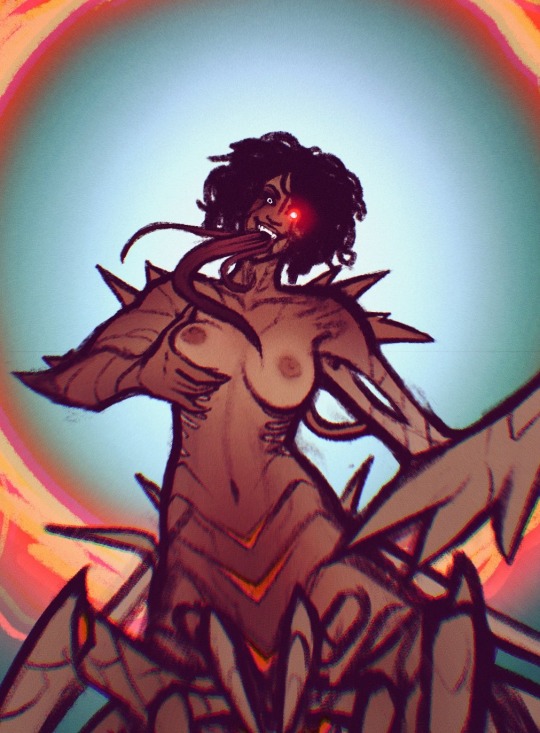
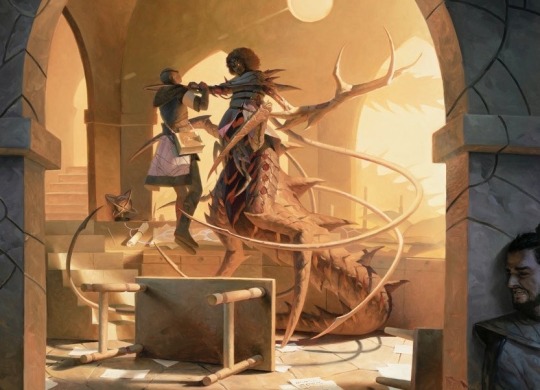
Fanart of Rona, Tolarian Obliterator
From Magic the Gathering
1K notes
·
View notes
Text
(And yes, I will draw it)
685 notes
·
View notes
Photo

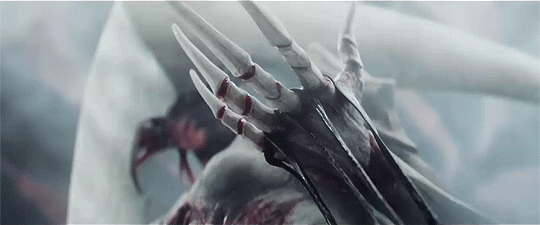

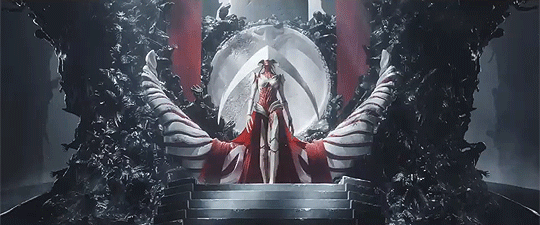
❝ Your realms are diseased, and we are the only cure. ❞
#elesh norn#magic the gathering#magic: the gathering#mtg#phyrexia#phyrexia all will be one#all will be one#step aside ashiok i have a new mtg obsession#tw body horror#✦ gifs
2K notes
·
View notes
Text
Felt like trying my hand at some more compleated walker designs!
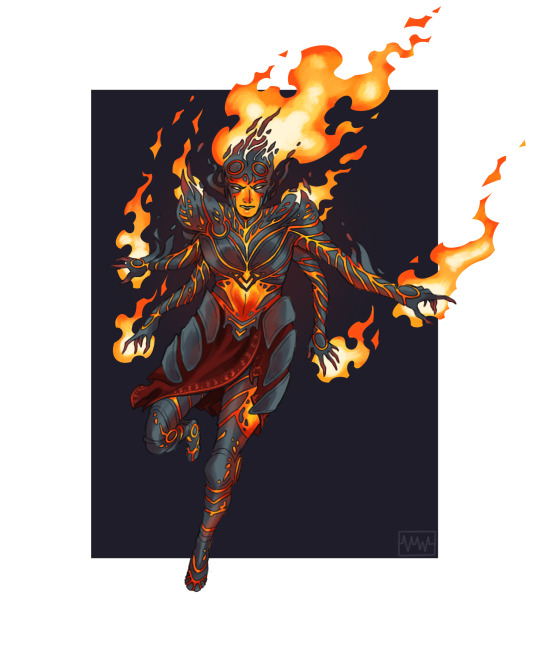
First, Chandra - the second design I drew, and my favorite of the three. I imagine that she could have willingly been completed, or just resisted Norn’s authority through sheer gay rage or something.

Next, Sorin - this was the last of the three I drew, but gave me so much trouble that by sketch number three I just decided to color it without inking. I might give this another try later.

Finally, mtg’s father of the year, Oko - the first design I did and the smoothest process by far. I just think he’s neat.
I might do more of these, so if you have any questions or suggestions for planeswalkers to compleat/redesign, I would love to hear from y’all!
#I have a pretty strong idea for Saheeli if anyone would be interested in that#my art#really need to use that tag more#mtg fanart#phyrexia#compleated planeswalker#chandra nalaar#sorin markov#oko
535 notes
·
View notes
Text
YOU ARE FIGHTING AN INFECTION. YOU ARE FEVERISH. YOU ARE BREATHING AND ALIVE. THE OIL IN YOUR VEINS IS A VIRUS.
#mtg#magic the gathering#magicthegathering#outlaws of thunder junction#jace beleren#vraska#vorthos#phyrexia#new phyrexia
244 notes
·
View notes
Text
Trans MTG players be like: Call me a phyrexian the way I be changing my body against what nature gave me to best suit my needs
817 notes
·
View notes
Text

Elesh Norn - sketchbook
#inkdrawing#inkart#sketchbook#sketch#fantasy art#horror#scifiart#magic the gathering#mtg fanart#phyrexia#new phyrexia
3K notes
·
View notes
Text




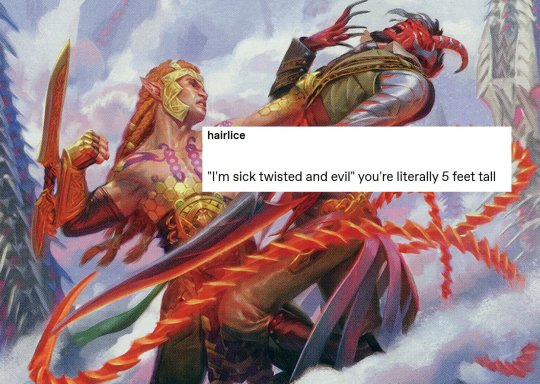
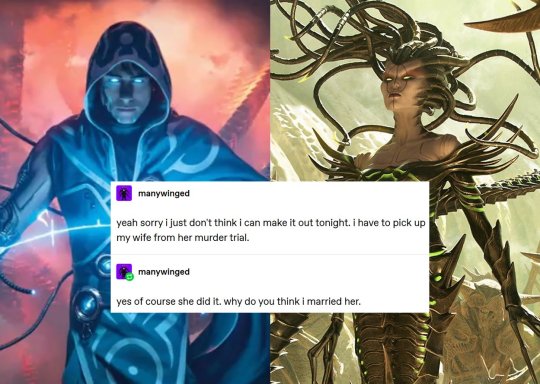


Praetors and Compleated Planeswalkers + Tumblr Textposts
#jin gitaxias#sheoldred#urabrask#Vorinclex#jace beleren#Vraska#Lukka#Nahiri#Phyrexia#new phyrexia#Tumblr textposts#magic the gathering#textpost memes
857 notes
·
View notes
Text

Compleat
#miku#Miku Monday#Hatsune Miku#vocaloid#phyrexian#phyrexia#MTG#like this better than our last phyrexian miku#still not quite there#was gonna do cannibalism but the pose felt too similar to the Saturn devouring his son one so you got this instead
295 notes
·
View notes
Text
Transformation, Horror, Eros, Phyrexia
There is another shore, you know, upon the other side.
- Lewis Carroll, “The Lobster Quadrille,”
ONE.

There is a moment early in H.P. Lovecraft’s 1931 novella The Shadow over Innsmouth where the nameless narrator looks out from the rotting seaside hamlet where he has lucklessly ventured, to the so-called Devil Reef some ways out in the harbor, darkened by a cloud of evil rumor—and something curious happens: the narrator experiences two opposed sensations simultaneously. The “long, black line” of the reef conveys “a suggestion of odd latent malignancy,” but also, “a subtle, curious sense of beckoning seemed superadded to the grim repulsion.” This bit of foreshadowing—the reef both calling and repelling the narrator—only finds its denouement at the very end of the story, after our narrator has narrowly escaped Innsmouth, the fish-like monsters who swarm in off of Devil Reef and their part-human descendants who inhabit the town in an unconvincing and repellent simulacrum of humanity. After his escape, the narrator does some genealogical research into his own troubled family history, full of disappearances and suicides, and concludes that he himself is one such abyssal hybrid. As he ages, he finds himself changing to resemble them, and in his dreams he swims among them in undersea palaces and gardens. The call of the deep becomes impossible to ignore:
So far I have not shot myself as my uncle Douglas did. I bought an automatic and almost took the step, but certain dreams deterred me. The tense extremes of horror are lessening, and I feel queerly drawn toward the unknown sea-deeps instead of fearing them. I hear and do strange things in sleep, and awake with a kind of exaltation instead of terror.
In the end, the narrator embraces the change and determines to flee to those oceanic depths, to live “amidst wonder and glory for ever.”
This is horror.
Something curious also happens in Shirley Jackson’s 1959 novel The Haunting of Hill House. Our heroine, Eleanor Vance, flees an unhappy life with a loveless sister to a haunted house, to take part in a paranormal experiment with three new friends. The haunting proceeds predictably but effectively: labyrinthine corridors, voices, unearthly cold, banging on doors, the rare apparition. The participants find themselves see-sawing between increasing night-time terror and a strangely intense joie de vivre by day, until one night, as the house seems to shake itself down upon its terrified guests in a dizzying cataclysm, Eleanor breaks:
She heard the laughter over all, coming thin and lunatic, rising in its little crazy tune, and thought, No; it is over for me. It is too much, she thought, I will relinquish my possession of this self of mine, abdicate, give over willingly what I never wanted at all; whatever it wants of me it can have.
By the next line, it is abruptly morning. The terror has ceased; the house stands. Its manifestations, for Eleanor, become benign: an unseen figure catches her beside a brook,
and she was held tight and safe. It is not cold at all, she thought, it is not cold at all.
She is through the horror now, on the other side of something. She becomes part of the haunting. Her senses encompass the whole of the house. She runs unafraid through the house by night, banging on doors, laughing as she eludes the other guests. When they finally catch up to her, it seems clear to them that Hill House has crept into her, that she has crossed some line, and they decide the best course of action is to send her away, in the hopes that with time she will return to this side, the normal side, the human side.
Instead, faced with rejection behind her and her old unhappy life before her, Eleanor Vance steers her car into a tree. There are holes which admit passage in only one direction. This, too, is horror.
In the 2018 film Annihilation, Lena (played by Natalie Portman) crosses a literal barrier called the Shimmer into a dangerous yet beautiful alien landscape full of mutated creatures. During their journey deeper into this territory, Lena and her companions realize that they themselves are also changing under the alien influence. Some break under the realization. Some surrender to the change and vanish into the landscape. Lena alone returns from the heart of the phenomenon, but she is no longer herself. Is this still horror? The film has many horror elements to it, but in this last moment, as she embraces her similarly-transformed husband, it is something else.
Cyberqueen, a 2012 text game created by Porpentine, draws on a legacy of godlike malevolent artificial intelligences in fiction (AM, from Harlan Ellison’s “I Have No Mouth and I Must Scream,” GladOS from the Portal games, and most importantly SHODAN from the System Shock series, who is cited as an inspiration eleven times in the Cyberqueen acknowledgements.) In this game, you awake from cryosleep on a colony spaceship where the shipboard AI has gone rogue. You fight her. You lose. You run. You are caught. You are forcibly cyberized, your mind surgically altered, your will brought into line with that of the AI. Finally, you kill or mutilate every other surviving human aboard the ship. It is filthily, overwhelmingly erotic throughout. (You can play it here, and I strongly recommend doing so if you have the stomach for it.)
This is no longer horror, is it? How can the same sort of transformation we encounter as horror in Lovecraft be encountered here as something to get off to? Well,
TWO.

I don’t remember now where I got the idea from, but there was a period in my childhood where I was terrified of the idea of time travel—specifically of the idea that someone in the future would invent it, travel to before I was born, and through the butterfly effect cause me to be born a girl instead. I used to lie awake at night circling the idea like a broken tooth. It was an irrational fear on multiple levels: I wasn’t afraid of being written out of the timeline through time travel, and I knew, intellectually, that in the timeline where I was born a girl I would have no memory of ever having been anything else, but even so, the horror of it caught me and held me by the throat.
This meant something, of course—in retrospect obvious, but at the time literally unimaginable, and it wasn’t until college, sitting at my computer in the dark in my dorm room at three in the morning, following the itching in my brain, that I unearthed alchemical knowledge: the transmutation of sex, male into female, in a dizzying profusion of form and process and—okay what I’m saying is I discovered forced feminization porn, yeah? It was revelatory. It was squalid. I was still Christian and couldn’t even bring myself to jerk off yet, so I sat there, the itch in my brain grown into a thunderous buzz, unable or unwilling to look away.
Forced feminization—I promise this is relevant—is the unwilling transformation of (usually) a man into (usually) a hyper-feminine woman, accomplished by a wide variety of means, including but not limited to blackmail, magic potions, nanite swarms, cursed artifacts, hacks or glitches in virtual reality programs, badly-worded wishes, industrial accidents, chemical leaks, abduction and surgery, medical malpractice, and hypnosis. You may notice that many if not all of these scenarios could be made into horror with little change, and in fact it is not uncommon for a poorly-written or over-ambitious forced-fem story to wind up as horror by accident (though of course this greatly depends on the tastes of the individual reader.)
(As an aside, I’d like to note that there is a great deal to learn from porn—not in terms of How to Do Sex, but about how the culture which produced it thinks about sex, and gender, and race and morality and technology and a host of other things. It’s a lot like popping the hood of a car and examining the engine. Sure, you wind up greasy and should probably wash your hands before you rejoin polite company, but if you don’t, you’ll never figure out the underlying issues. Actually, it’s a lot like horror in that regard.)
Let’s talk about a very different transformation I was undergoing at the same time: the loss of my faith. I was raised, as mentioned, very Christian—and in one of the worst strains of fundamentalist white American Evangelicalism. I was a true believer: the world for me was entirely divided between the faithful elect and the unbelievers, who must necessarily know the truth of the (fundamentalist white American Evangelical) gospel in their hearts, but had wilfully chosen to oppose Christ. The prospect of passing from the elect into the category of the unbeliever was unthinkable. The process of deconversion led only into the outer darkness and the weeping and gnashing of teeth.
And yet I found myself on that precipice anyway. The worldview of FWAE is not one which survives too much contact with the actual world, and I had chosen against my parents’ preferences to go to a secular university, the better to witness to the unsaved. In the end, the process I had been mortally afraid of consisted of a couple days’ agonized thought, unanswered prayer and tearful calls to my unresponsive parents and pastor, after which I emerged into a world much bigger and much more complex than the one I’d grown up in. The serpent had told the truth after all: I had eaten of the fruit, and had not died.
Okay: is this horror? Reader, forgive me for presupposing anything about your perspective, but you’re on a horny lesbian Magic: the Gathering card art review tumblr, so I’m going to assume that losing one’s hateful, fundamentalist faith is the opposite of horrifying to you. But it was, absolutely, horror to contemplate for someone on the other side of that process.
But then... is the horror of any given transformation only a matter of where you’re standing? If you read The Shadow over Innsmouth aware of Lovecraft’s profound racism, it becomes very, very obvious that the horror of Innsmouth is the specter of miscegenation. The narrator’s horrified cataloging of the facial features of the offspring of fishmen and humans, the South Pacific origin of the sea-devil-worship of Innsmouth brought back by an enterprising merchant captain, the fear of the unsuspected poison of one’s own ancestry lurking in one’s own blood: all of this is much less effective as horror for someone living in a country where interracial marriages are protected under law and seen as unproblematic in consensus morality (assume whatever asterisks are necessary for the complicated landscape of attitudes toward interracial relationships in the United States, please, I do not have the expertise or desire to get into it here.) My point is that since 1967 (asterisk asterisk asterisk), we are through to the other side of that horror, and it turns out there literally wasn’t anything to be afraid of. The pelagial palaces and terraced coral gardens of Y’ha-nthlei just sound beautiful to me.
And it’s hard for me—though I may be in the minority here—to view Hill House as the primary antagonist in Jackson’s novel. The true source of evil is all the things Eleanor runs from and therefore brings with her: her cruel, deceased mother, her exploitation and infantilization by her sister; as well as the final polite unwillingness of her new friends at Hill House to do anything but send her away once she goes inconveniently mad. These mundane ills are what sends Eleanor Vance careening into the tree, not the supernatural will of malignant architecture.
Here, then, is the better part of my thesis: transformation horror is something that can be traversed. You can come out the other end of a transformation unrecognizable to you-as-you-were, and yet still very much yourself. Moreover, it is this navigability, this double-sidedness which so closely links the horror of transformation to the eros of transformation. Not all transformation horror, passed through, becomes plainly erotic, but it is very often portrayed as a kind of seduction, and it is difficult for me to conceive of eros without some kind of change. Desire is a kind of transformation, is it not?
In fact, isn’t it true that a great many of us have already passed through such a transformation? Recall yourself as a child, as you were when you first learned about sex: wasn’t there something repellent and unhygienic about the idea? Wasn’t there a small horror in being told, you will change, and this will cease to be loathsome and become something you desire fervently, something you seek out, something you go to great lengths to experience? ...or were you, possibly, raised in a family & culture that was normal about sex and bodies? I admit I may be generalizing my individual neuroses to some extent here. Well, stet, at the very least you can see where I’m coming from.
THREE.

Returning for a moment to the subject of porn: why forced feminization, specifically? There are—you’re going to have to trust me here—no shortage of ways in the real world by which a man transforms into a woman, and very few of them involve coercion or all the horror-adjacent setup of, say, mind-control devices or vengeful curses. Why does a simple story of a willing gender transition fail to function as erotica? Why did it take stories of unwilling transformation for me to learn I was transgender? What’s the juice ne sais quoi at play in forced-fem?
Well, how does Luke Skywalker come to leave Tatooine? He gets a mysterious message from a princess, a desert wizard tells him to come help rescue her, and... he says no. He has obligations to family here, a job to do, power converters to bring back from Tosche Station. He is enmeshed in a social web, like all of us: it surrounds us, penetrates us, binds the galaxy together and so forth. So in order for Luke to go on grand adventures, the story needs to murder his aunt and uncle and sever those threads of social obligation.
Joseph Campbell, monomyth monomane that he was, would say this is “Refusing the Call” and find it in Jungian shadow on every cave wall, signifying something important in the heart of humanity, but really this is just a useful storytelling tool: a story needs change, but a virtuous protagonist cannot simply abandon their obligations and designated social role to go gallivanting off into space, so change must be forced upon them.
The bodice-ripper romance novel, the rape fantasy, the forced feminization story are all operating on a similar premise: you are so wrapped in society’s web, in your socially-dictated identity, that you cannot even acknowledge your desires on the level of conscious thought. When these things are enacted on your body, you will find yourself changed by the experience. You will love what has been done to you, and you remain blameless, since it’s not as though you sought this out.
These are liberatory fantasies. The lack of consent is precisely what allows you to move beyond what is permitted you into something new.
Incantation Against Bad-Faith Interpretation because I, a transsexual, just called rape fantasies “liberatory”: I am talking about fantasies, I am talking about why people fantasize about having their consent violated, I am talking about the role such fantasies play and what they can tell us about horror and desire. I am not advocating for real people to have real bad things done to them in real life, fuck off, End of Incantation.
So then, we’ve assembled the full thesis: transformation horror is traversible to the other side, and is inextricably linked to transformation erotica, both because of the seduction of transformation in horror and because the horror of transformation unlocks regions of desire which would otherwise have remained inaccessible.
Okay, now we can talk about Phyrexia.
FOUR.

I hear the roar of the big machine / Two worlds and in between / Hot metal and methedrine / I hear empire down
- The Sisters of Mercy, “Lucretia My Reflection”, from Floodland
Phyrexia is many things—a world, another world, a faction, a kind of creature—but I think it can most succinctly be understood as a virulently contagious biomechanical body horror cult dedicated to the ultimate incorporation of all things into itself. It’s a bit like Star Trek’s the Borg, if the Borg had any style whatsoever. It draws heavy inspiration from H. R. Giger’s work—some Phyrexian horrors are barely-altered versions of the xenomorph from Alien—as well as from Clive Barker’s Cenobites in Hellraiser, whose alien BDSM schtick is especially influential on the aesthetic of New Phyrexia. It is transmitted through glistening oil, an infection vector capable of reshaping bodies and minds, and given enough time, whole worlds. The process by which a being is made into a Phyrexian, “compleation,” is accomplished via glistening oil exposure, surgery, cyberization, and brainwashing.
This essay is in many ways a response to Rhystic Studies’ latest video, called “Phyrexia is Hell”. I think it’s a well-made video, as is true of all Sam Gaglio’s work, and a lot of it is really good—the overview of the nearly-thirty-year history of depictions of Phyrexia in Magic: the Gathering art is invaluable, and the stuff about the Phyrexian conlang is unbelievably cool—but the way he identifies Phyrexia one-to-one with a pretty facile understanding of transhumanism leads him to confused and frankly silly conclusions, like placing Phyrexian compleation on the same continuum with cosmetic orthodontics. Like,

Mandible Justiciar (art by Mike Franchina)
Phyrexia is perfectly happy for you to have teeth in your arms instead of your head! They don’t care about the narrow ideal of a conventionally-attractive human smile. This is a whole other thing.
Now, I don’t want to come down too hard on Gaglio here for a couple of reasons: one, he is very good at what he does (see his videos Understanding Sagas and Red Deck Wins, for example); two, it’s reasonable to say that a full understanding of transhumanism is beyond the scope of a video essay about the tiny pictures on cards for dweebs; and three, most importantly, because I see people make this same mistake all the time. People focus on the things that are textually true about Phyrexia and miss the tension between that and the very different things currently being said by the Phyrexian aesthetic. They miss the razorverge thicket, as it were, for the mycosynth trees.
For instance: it is textually the case that Phyrexia is a sort of fascist cult stemming from the depraved machinations of a dead eugenicist god. Contrast, however, other fascist factions in science fiction: the Imperium of Man from Warhammer 40K worships a massive Aryan god-emperor übermensch, its battles are fought by nine-foot-tall genetically-engineered supersoldiers, and it slaps either skulls or chainsaws on every available surface. The Galactic Empire from Star Wars has legions of identical, uniform stormtroopers. Even the Borg all look alike. Phyrexians talk of ideal perfection of form and then make ten thousand completely different monsters. Phyrexians talk of perfect unity and splinter into nearly a dozen factions who can’t even agree on a name for what they’re trying to accomplish. Other fictional fascisms don’t do this—sure, there’s internal contradiction, as in real fascism, but the core aesthetic remains recognizably, sometimes indistinguishably fascist. You can easily find terminally-online Nazis using Warhammer 40K lingo with that peculiar sincerity which is indistinguishable from irony when you’ve decided the truth doesn’t matter, but it would be a lot harder to find some alt-right bozo going all-in on the Glory of Phyrexia. The aesthetic is all wrong, and fascism’s aesthetic is one of its few consistent features.

Mondrak, Glory Dominus (art by Jason A. Engle)
You see what I mean? The aesthetic evokes a sort of alien fascism, but the art itself would be considered “degenerate” by actual fascists.

Tamiyo’s Immobilizer (art by Daren Bader)
This is much, much closer to Mapplethorpe than to Riefenstahl. And people respond to Phyrexia similarly! The body horror and grotesquerie make them uncomfortable, and then they try to moralize that discomfort. This has been happening at the very least since 2011 with the release of New Phyrexia, and I have seen people on Tumblr arguing in total sincerity that people who are into Phyrexia are making themselves susceptible to real-life cult recruitment (again, the heterogeneity of form in Phyrexia is incompatible with the enforced uniformity of cults and other high-control groups. The appeal of Phyrexia does not translate into real-life cults.)
So, okay, what is the appeal of Phyrexia? Well, you get a sick fuckin cyborg body, is what. Many of us, for various reasons (disability, disease, gender, and so forth) find ourselve intensely dissatisfied with our own bodies, and wanting to radically alter them. Many of us already have. Yes, you surrender your humanity when you are compleated, but we know first-hand that “humanity” is socially-constructed and contingent on certain kinds of conformity. We’ve had our humanity doubted, interrogated, stripped away. We’ve done without. It’s not too high a price to pay, if we get to look like this at the end:
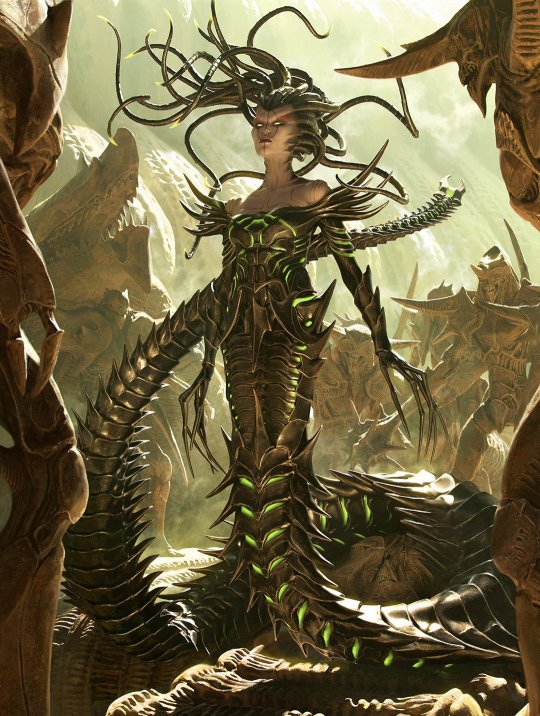
Vraska, Betrayal’s Sting (art by Chase Stone)
I’d even argue that getting to reject humanity as it has rejected you is part of the appeal of compleation. This isn’t quite transhumanism; I might call it exhumanism: the freedom to unearth a way of being that is no longer being human. This is why compleation is coercive, remember? The fantasy allows you to get to this point without making the unimaginable decision to reject not only your individual social obligations, but the idea that you could owe anyone or everyone any kind of social conformity simply for having been born into your species—and then you get to be a cool and powerful cybergorgon.
This, then, is why I don’t blame someone like Sam Gaglio (who is to the best of my knowledge both cisgender and able-bodied) for not really getting what’s going on with Phyrexia. He lives on the before side of the horror of transformation; he’s never had to cross over.
In fact, I’d go one step further here. Phyrexia has existed for almost thirty years, and in that time it’s changed quite a bit. Gaglio quotes an article by Rob Bockman in Hipsters of the Coast which comments on how the shift in the depictions of Phyrexia from 1994 to 2000 reflected shifts in cultural fears over time. The Satanic Panic shaded into multidirectional Y2K anxieties, and the necromancy of original Phyrexia mutated into technological horror. This is what effective horror does: it reflects the fears of its age back to us.
Today, Phyrexia is a seductive, corrupting influence. They have figured out how to compleat planeswalkers—the protagonists of Magic storylines; named, important characters (and Lukka)—which was previously thought impossible. Characters we knew and loved (and Lukka) are seduced, brainwashed, bodily violated, surgically altered, and returned to us unrecognizable. It is not coincidental that this version of Phyrexia is concurrent with the worst wave of anti-transgender legislation to hit the United States in decades—legislation which plays on the specters of the transsexual bathroom predator and on the brainwashed child transitioner, on the idea that transsexuality is a form of social contagion we must protect our children from even learning about. The horror of Phyrexia in its current incarnation is a mirror of our cultural fear of transsexual bodies.

Irreversible Damage: the Transgender Craze Seducing Our Daughters (art by Lauren K. Cannon)
I want to be very clear here—actually, one moment, my extremely funny Abigail Schrier joke notwithstanding, I do need to tell you that the actual name of the above card is “Furnace Punisher”, which is just peak Phyrexia—I want to be clear that I am not ascribing any kind of malice or antipathy towards trans people, either intentional or unconscious, to Wizards of the Coast or the people who make Magic: the Gathering. I would be shocked if anyone there set out to make Innsmouth-style horror about transsexuals. Nor am I upset that they kind of have! Something being fun and interesting is way more important to me than whether or not it’s problematic, and it’s not like I haven’t seen way more vicious horror about transsexuals. We’ll laugh about this someday, in the coral gardens of Y’ha-nthlei, and you’ll wonder what you were ever so afraid of.
In fact, this is another reason why Phyrexia is so appealing to people like us: we are a kind of social contagion. We are carriers for the viral idea that modes of being outside patriarchy and the nuclear family exist; that gender is a marketing demographic, not an ontological truth; that damn near everything about the world we’ve built is not a necessary fact but a social construct contingent upon a half-dozen other social constructs. A new world grows from many, many seeds, and this one germinates in us.
Anyway! What were we talking aboFIVE.

//please state your name for the record
bone-wife / spit-dribbler / understudy for the underdog / uphill rumor / fine-toothed cunt
- Franny Choi, “Turing Test”, from Death by Sex Machine
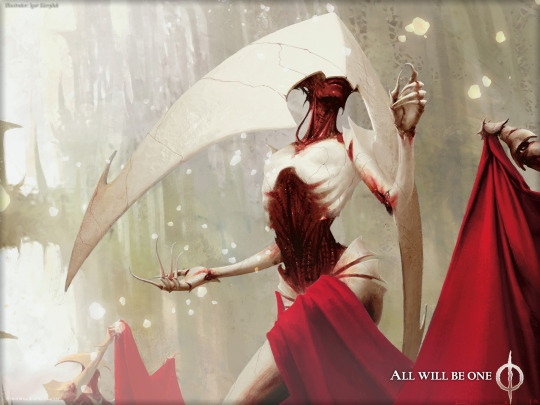
Elesh Norn, Grand Cenobite (art by Igor Kieryluk)
There is a gravitational pull this painting exerts on people. Even people who don’t get Phyrexia find themselves drawn in, find it difficult to look away (e.g. 26:30 in that Rhystic Studies video.) I have for a long time maintained that Elesh Norn is the hottest character in Magic, and that Kieryluk’s portrayal of her is the best art in Magic, and neither of these opinions are particularly surprising coming from me. What is surprising is just how many people also converge on Miss Multiverse’s-Most-Fuckable-Pyramid-Head as, not just a sex icon of Magic: the Gathering, but the sex icon.
Well, or is it? Giant anchor-shaped porcelain mask aside, her silhouette is more or less that of a painfully-thin woman; she stands fully twelve feet tall, and we remember how wild everyone went over Resident Evil: Village’s woman who was only three-quarters of that; and though not an artificial intelligence herself, it’s hard not to place her somewhere in the Cyberqueen lineage. Like SHODAN, like GladOS, like Cyberqueen, she exerts a near-omnipotent level of control over (part of) her world; like them, she is a megalomaniacal egotist (though she cloaks her egotism in piety); like them, she is happy to render you more useful to her via surgery, brainwashing, or deadly neurotoxin. Her mask obscures where her eyes would be, and if I’ve learned anything from a decade of playing or mostly watching other people play the various Dark Souls games, it’s that people go apeshit for character designs without visible eyes (see also: the xenomorph from Alien; I did a whole thing on this subject somewhere back in the Wifelink archive.) So you’ve got a 12′ nigh-omnipotent eyeless dominatrix mostly shaped like a skinny woman, which is maybe pushing a whole lot of buttons at once for a lot of people.
As a character, we don’t know much about her: at some point, she became undisputed leader of the Machine Orthodoxy, the cultiest bit of New Phyrexia. At a later point, she became the extremely-disputed leader of New Phyrexia as a whole. She likes long walks on the beach and multiversal Phyrexian dominion, you get it. There is, however, one good story featuring her, and it is “A Garden of Flesh” by Lora Gray (sorry to give you additional reading in a five-thousand-word essay.) The story is interesting because it is the rare story told from a Phyrexian point of view, and because it flies in the face of many of our assumptions about Phyrexian interiority. Phyrexians, we’re told, lack souls. They’re unfeeling, more machine than man. They most certainly don’t dream.
“A Garden of Flesh” is what happens when Ashiok, planeswalker architect of nightmares and an eyeless smokeshow in their own right, gets curious about whether they can induce nightmares in a Phyrexian mind. What follows is a curiously-effective piece of body & transformation horror, told from the point of view of what is supposed to be the awful endpoint of transformation horror. What does a perfect, powerful biomechanical creature fear? The organic, soft, spongy. Putrefaction. Decay. What does such a creature fear becoming? Human.
I didn’t devote a fifth of this essay to Elesh Norn just because she’s unbelievably hot (although dayenu), but because of this story, and how it complicates our thesis. The horror of transformation is traversible, yes, but what will you find on the other side? More transformation. More horror. And transformation is inevitable: who of us are who we expected to be? Who of us still hold dear the precious things of childhood? And even you few who are raising your hands right now, you too will experience transformation. Should you live long enough, you will find yourself changing. Your body and mind will grow rebellious, unreliable. You will grow old. You will decay.
And yet—it’s a matter of perspective, of where you weight your focus, isn’t it? There will always be more transformation and more horror, but there will always be a way through it. There will always be another shore upon the other side. You will change. You will become unrecognizable to who you were before. You will be fine.
Incompleat Bibliography & Further Reading/Viewing/Playing
Rhystic Studies, “Phyrexia is Hell”, 2023.
H. P. Lovecraft, The Shadow over Innsmouth, 1931.
Shirley Jackson, The Haunting of Hill House, 1959.
Alex Garland, Annihilation, 2018.
Harlan Ellison, “I Have No Mouth, and I Must Scream”, 1967.
Ken Levine, System Shock 2, 1999.
—never played it myself. Mostly I just open up a youtube video of SHODAN voice lines when I want to get belittled by an AI dominatrix.
Valve, Portal 2, 2011.
—there is a lot more to be said about GladOS and Elesh Norn specifically and their respective fraught relationships with the idea of their own humanity.
Porpentine Charity Heartscape, Cyberqueen, 2012.
—whence my chapter header screenshots. Seriously, this game fucks so hard.
Franny Choi, Death by Sex Machine, 2017.
—Choi is making extensive use of cyborg metaphor to address the specific experience of being a Korean-American woman. This is very different from anything I’m talking about, but it also always felt extremely relevant to me as a trans woman. Subaltern-to-subaltern communication.
Lora Gray, “A Garden of Flesh,” 2022.
—it’s no accident that the author of the one good story told from a Phyrexian POV is nonbinary.
hbomberguy, “Outsiders: How To Adapt H.P. Lovecraft In the 21st Century”, 2018.
Jacob Geller, “Who’s Afraid of Modern Art: Vandalism, Video Games, and Fascism”, 2019.
Caitlín R Kiernan, The Drowning Girl: A Memoir, 2012.
—only tangentially relevant, except insofar as it recontextualizes the Lewis Carroll line I open the essay with, and insofar as it is my favorite novel and I’m writing the bibliography. Debatable whether it counts as transformation horror, and I imagine the author would bridle at its being described as horror, but nevertheless: you should read this book.
2K notes
·
View notes
Text

Atraxa - Magic the Gathering fanart
547 notes
·
View notes
Text

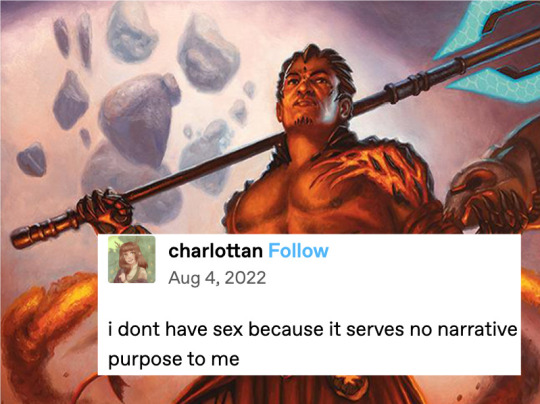

413 notes
·
View notes
Text
Phyrexia from the outside is body horror. Phyrexia from the inside is dystopian, reproductive horror.
148 notes
·
View notes
